Have you been planning to build a raised garden bed for a long time, but you’ve been afraid to start because of all of the unknowns? Then you are in the right place. This article will alleviate your fears and guide you step-by-step in the process of building a raised garden bed. In addition, it will help you avoid common mistakes made by beginners and even experienced gardeners.
Raised gardens, also called planter boxes, are an excellent choice for growing vegetables and other food items in the backyard of your home. The flexibility to build a garden anywhere is the most notable benefit of raised planters. Moreover, they are a valuable, beautiful, and healthy addition to any home. For people with back pain or knee problems, growing a garden in a raised garden bed is a no-brainer, because it allows you to take care of your crops without bending over.
Some beginners hesitate because they do not know what materials are required and think that building a raised garden will require a lot of time and investment. You can build a raised garden bed using wood, metal, or plastic. Optionally, if building one from scratch yourself isn’t your thing, you can always purchase affordable and easy to put together raised garden bed kits of different materials, shapes, and styles. You can also find horizontal or vertical structures to meet your space requirements as well as planters with wheels for easy movement. Once the raised bed is constructed, don’t forget to use suitable soil. The exact amount will vary depending on the size of your garden bed.
![Building A Raised Garden [The Ultimate Guide]](https://wraxly.com/wp-content/uploads/2021/05/Building-A-Raised-Garden-The-Ultimate-Guide.jpg)
- Benefits Of Raised Garden Beds
- How To Build A Raised Garden Bed Step-By-Step
- What You Should Plant In Raised Garden Beds
- Common Mistakes Made By Beginners
- Raised Garden Bed Ideas
- Brick Raised Garden Beds
- Metal Sheet Raised Garden Beds
- Square Foot Raised Garden Beds
- Spiral Raised Garden Beds
- Hoop House Raised Bed
- Raised Bed Border
- Trough Gardens
- Custom-Designed Raised Beds
- Raised Bed with Trellis
- Raised Beds Lining Walkway
- Colorful Cinder Block Raised Bed
- Tiered Raised Bed
- Door Panel Raised Beds
- Basic Square Garden Bed
- Milk Crate Raised Garden Bed
Benefits Of Raised Garden Beds
There are many benefits of raised garden beds. If you are a beginner, I guarantee you will love building your own raised garden. And it really isn’t that hard. The biggest benefit of owning a raised garden bed is that it gives you the freedom to grow your favorite flowering plants, vegetables, and herbs, which sometimes is not possible in a regular garden due to poor quality soil. In raised gardens, you can choose a soil based on the requirements of your crops. A good quality soil helps a plant grow better.
Raised Garden Beds Make Pest Control Easier
Another benefit of a raised garden bed has to do with controlling pests. Pests and weeds harm plants in many ways and sometimes, it becomes so hard to get rid of them that they can destroy your whole garden. Pests may damage or kill your plants and weeds eat up a lot of soil nutrients and slow down the growth of your plants. An important benefit of raised garden beds is that controlling pests and weeds is much easier.
Raised Garden Beds Are Ergonomical
Another benefit is that no bending is required for day-to-day gardening activities. The ergonomics of a raised garden is ideal for your body, which will especially be appreciated by people with issues in their knees and backs.
Compared to in-ground gardens, raised garden beds cost a little more. However, believe me, it is totally worth it.
How To Build A Raised Garden Bed Step-By-Step
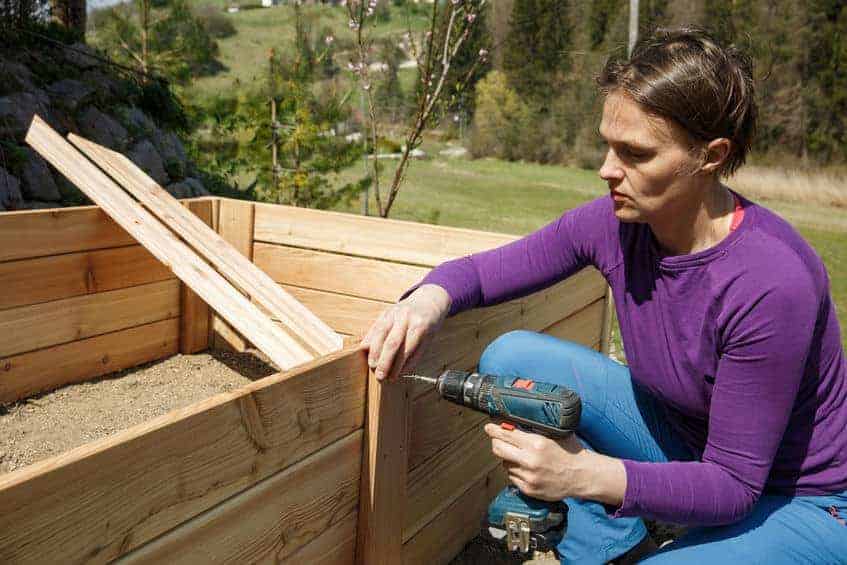
- The first step to build a raised bed is to choose the location where you will be planting. Choose a place where the sun will be shining the whole day, because most plants will need the sun’s rays for their growth. However, some plants like lettuce, spinach, kale, and arugula work well with partial shade too. If you live in a warmer climate, your plants will thrive!
- The next step is to choose the wood to build your garden. You can use two planks of wood that are 8 feet (2.4m) long. Cut these in half and make a square bed 4 feet long. A garden bed this size is ideal, as you will not have to step inside the bed to tend to your plants.
- The next step is to prepare the ground for planting. Start by laying cardboard over the area where you will be putting the raised garden bed. The cardboard will help in clearing the grass and weeds underneath. Spread the cardboard all over the area to keep it free from grass and weeds.
- Now that the ground has been prepared, it is time to make your raised garden bed. With a measuring tape, mark halfway through the planks. Saw both the planks to create the four walls of your raised garden bed. Make sure that they are of equal length.
- Next, drill some pilot holes in the plank to screw the walls together. Position your pilot holes in such a way that one end of each plank will overlap the other and screw directly into it. Make it a snug fit.
- With your walls fitted, now is the time to fill in your raised garden bed. The soil is the most important part of your garden. The more organic matter there is in the soil, the better. When filling your raised garden bed, look for a soil mix that is at least 40 percent compost, 40 percent topsoil, and 20 percent aeration material. You can find the proper raised garden soil in your local garden center. As for aeration, you will find bagged soil mix already mixed with aerators like perlite, lava rock or pumice.
Recommended Soil Amendments
| Image | Title | Prime | Buy |
|---|---|---|---|
 | The Andersons BioChar DG Organic Soil Amendment - Covers up to 5,000 sq ft (10 lb) | PrimeEligible | Check Price on Amazon |
 | Nectar for the Gods NGOS3004 One Shot Granules, 4 lb Soil Amendment, Black | PrimeEligible | Check Price on Amazon |
Top | Worm Castings Organic Fertilizer, Wiggle Worm Soil Builder, 30-pounds | Prime | Check Price on Amazon |
 | Aries Green Biochar Soil Amendment 5-Gallon Plastic Bucket – USDA, IBI Certified – 100% Biochar | Prime | Check Price on Amazon |
 | Turbo Soil Bio-Blend, Superior Organic Soil Amendment (3 lbs) | PrimeEligible | Check Price on Amazon |
What You Should Plant In Raised Garden Beds
Now that you have learned how to build a raised garden, it is time to plant your favorite vegetables, fruits, herbs, and flowers. You can also try grouping four or five beds together to make a proper garden.
Remember, the depth of the soil of your raised garden bed will limit what you grow. Below is what plants grow in what depth.
- In a six-inch soil depth, you can grow plants like lettuce, onions, leeks, radishes, salad greens, spinach, strawberries, herbs like chives, basil, mint, cilantro, dill, thyme, parsley, and oregano. Marigold and other annual flowers will also thrive in this soil depth.
- In a twelve-inch soil depth, everything that was in the six-inch soil list can be grown. Plus, you can grow beets, cabbage, beans, cauliflower, broccoli, Brussel sprouts, cantaloupe, cucumbers, collards, turnips, garlic, squash, kale, rosemary, lavender, borage, sage, lantana, nasturtiums, cosmos, sweet alyssum, and snapdragons.
- Now, we come to the eighteen-inch soil depth. In addition to everything on the six and twelve-inch list, you can additionally grow okra, eggplant, peppers, sweet potatoes, watermelon, pumpkins, and winter squash.
Common Mistakes Made By Beginners
When planning to start a raised garden bed, you may be full of enthusiasm and a lot of energy. And why not? A raised garden bed is much more advantageous and profitable than a normal garden. It offers easy accessibility, you have control over the soil you are putting in the bed, there is considerable improvement in drainage, and the soil is warm enough to guarantee faster growth of plants. Nevertheless, before you start building your raised garden bed, there are some pointers to keep in mind. Some very common mistakes can spoil all your hard work. So to avoid doing so, keep these points in mind:
- Just like in real estate, the three most important considerations are location, location, and location. So remember, sunlight is very important for your plant’s growth. They must receive at least six hours of sunlight. Pick a place that is a little flat, but do not choose low-lying areas where rainwater can collect. Also, keep in mind that putting your raised beds against a fence hinders you from accessing it from all sides.
- The most common mistake people make when building their raised garden beds is not looking for a water source nearby. If you have to lug around buckets every day to water your plants, your enthusiasm will soon fizzle out. Your garden bed should be near a garden faucet or somewhere you can easily reach with a hose. Watering your plants is very important, so remember that!
- You must have the right material to build your raised garden bed. Avoid using material that is prone to decay or wear. Also, avoid chemically-treated lumber because it will release those chemicals into your soil. Go for oak, cedar, redwood, or stones and bricks, which are long-lasting and chemical-free.
- You may think every kind of garden soil is best for your garden. However, it is not. You should never use garden soil in a container garden or in a raised planter. Using it in raised garden beds will hinder the drainage process of the plants. Use only bagged soil specifically designed for raised garden beds. This soil also helps kill any weeds, insects, and diseases.
- Do not be tempted to make your raised garden bed too big. It should be narrow enough that you would be able to reach halfway across it easily to plant, water, weed, or harvest. Do not make it too long either. It will take you a long time to walk around it. It is better if you create multiple raised garden beds instead of one.
- When selecting the plants for your raised garden bed, do not select very large plants. Understand the scale of growth of the plant with the size of your bed and then plant it. If you have a small raised garden bed, go for dwarf varieties of the plants you want to grow.
- Do not skip mulching. Even though raised garden beds are off the ground, they are prone to weeds. Add a layer of mulch to the soil to keep weeds from growing. In addition, mulch also helps in retaining water around your plant’s roots.
- Protect your plants from hungry herbivores. Install fencing to keep deer or other plant-loving animals away from them. You can also use an odor-based repellant on the soil, which will keep these animals away.
Raised Garden Bed Ideas
The great thing about raised garden beds is that it gives you an opportunity to show your creativity. You can make it as simple or as stylish as you want. A raised garden bed can be a permanent place in your home where flowers will bloom all year round. Maybe you will want vegetables, herbs or fruit trees. It is your choice, really. Listed below are some raised garden bed ideas to make your garden more aesthetically pleasing.
Brick Raised Garden Beds
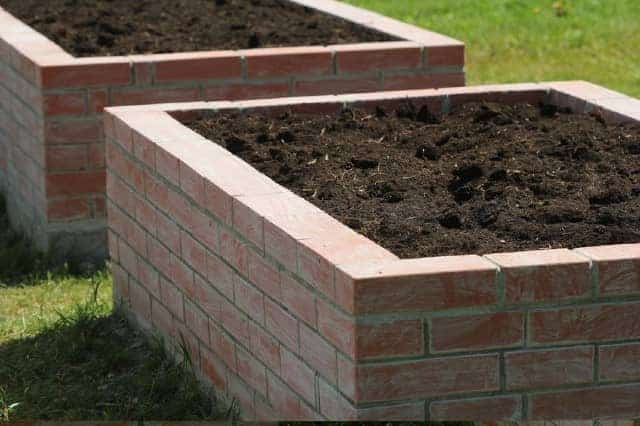
Plants grow better and healthier when they are cultivated at places where they get proper sunlight and shade. The raised gardens provide this flexibility, but in-ground gardens do not. You can use bricks to build your raised garden bed and place it where the cultivated plants will receive sufficient sunlight and shade. A garden bed made of bricks prevents burrowing pests and will protect your plants. In a raised bed, plants are more productive and healthy because you can control the soil and water drainage. Moreover, bricks lend an aesthetic appeal to your raised garden bed.
Metal Sheet Raised Garden Beds
Raised garden beds sit above the ground, so the soil remains warmer in the winter than in a normal garden. It also allows you to plant sooner. With sheet metal, the heat will be retained in the soil for a longer time. In addition, sheet metal can be easily molded into different shapes. It provides a uniform color to your garden and you can easily give it the shape you want. For plants like lavender and sage, sheet metal raised garden beds are the best, as they need more warmth than other plants.
Recommended Metal Sheet Raised Garden Beds
| Image | Title | Prime | Buy |
|---|---|---|---|
 | FOYUEE Galvanized Raised Garden Beds, 8x4x1ft | PrimeEligible | Check Price on Amazon |
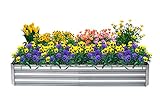 | Galvanized Raised Garden Beds Metal Planter Box, 6 ×3 ×1 FT | PrimeEligible | Check Price on Amazon |
Top | Land guard 6ft Metal Raised Garden Bed, 2 Pcs | PrimeEligible | Check Price on Amazon |
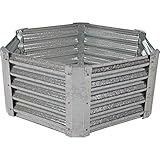 | Sunnydaze Raised Metal Garden Bed Kit, Galvanized Steel 40-Inch Hexagon Planter, 16 Inches Deep | PrimeEligible | Check Price on Amazon |
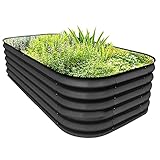 | PINTIA1 Steel Raised Garden Beds Galvanized Steel (6X3X1.45 FT, Charcoal Grey) | PrimeEligible | Check Price on Amazon |
 | zizin Galvanized Raised Garden Beds Kit (6 ×3 ×1 ft) | PrimeEligible | Check Price on Amazon |
Square Foot Raised Garden Beds
With this style of raised garden beds, you can plant a highly productive garden. Square foot gardening will involve dividing the area into around one foot square sections and plant your vegetables in it. It is generally meant for high cultivation and production of vegetables.
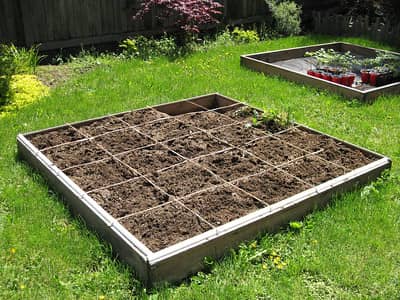
Recommended Square Foot Raised Garden Beds
| Image | Title | Prime | Buy |
|---|---|---|---|
 | Gardzen 2 Pack Divided Raised Vegetable Bed, Square Foot Gardening 2Feet x 2Feet - Having Your Own Garden | PrimeEligible | Check Price on Amazon |
Top | Vita Gardens 4x4 Garden Bed with Grow Grid, Packaging may vary | PrimeEligible | Check Price on Amazon |
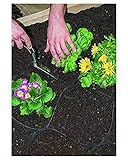 | GardenPODS Square Foot Raised Garden Bed Grid | Prime | Check Price on Amazon |
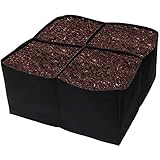 | JaoNanl 2-Pack 30 Gallon Fabric Plants Grow Bags 2x2 Feet 4 Square Planting Bag Non-Woven Fabric Garden Bed Indoor Outdoor Growing Bag Smart Fabric Pots for Vegetables, Fruits, Flowers, Herbs | PrimeEligible | Check Price on Amazon |
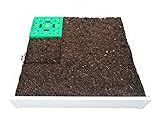 | Handy Bed 3 x 3 Square Foot Design, Stack-able, White, Vinyl, Raised Garden Bed | Prime | Check Price on Amazon |
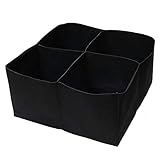 | 2 Pack Fabric Raised Garden Beds 2FT X 2FT 4 Holes Square Fabric Raised Planting Bed for Vegetables Outdoor and Indoor | PrimeEligible | Check Price on Amazon |
 | kdgarden Raised Garden Bed Kit 4'x4' Outdoor Above Ground Planter Box for Growing Vegetables Flowers Herbs, DIY Gardening, Whelping Pen and More, Screwless White Vinyl Garden Bed with Grid | PrimeEligible | Check Price on Amazon |
Spiral Raised Garden Beds
Spiral raised garden beds look very charming and are very easy to make too. A spiral raised garden bed increases the total planting area without taking up much space. They are very easy to construct too. You can make them out of stone, brick, wood or by simply piling up the soil to build a crude structure in the shape of a swirl. The shape and swirl of the garden bed looks very eye-catching. You can plant vegetables, herbs, or flowers in these raised garden beds.
Hoop House Raised Bed
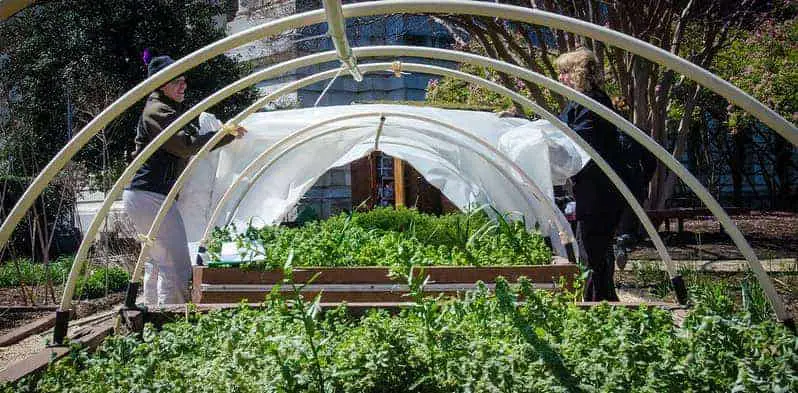
A raised garden bed lets you grow any seasonal vegetables or herbs, as it provides you flexibility to control the cultivation conditions, soil quality, water drainage, and sunlight. You can prepare your raised garden bed for all weather conditions by building a hoop house on top of it. It can handle extreme weather conditions, including frost and sun. With this, you can start cultivating your favorite vegetables anytime. Also, with little effort, it saves your vegetables from animals. To build your own hoop house raised bed, check out our recommendations below.
Recommended Hoop House Raised Garden Bed Kits
| Image | Title | Prime | Buy |
|---|---|---|---|
 | Outsunny 9' L x 3' W x 3' H Portable Greenhouse with Zipper Doors & Water/UV Cover | Prime | Check Price on Amazon |
Top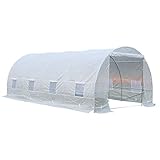 | Outsunny 20' x 10' x 7' Walk-in Tunnel Greenhouse Kit with 8 Roll-up Windows & Roll Up Door, Steel Frame, White | Prime | Check Price on Amazon |
 | Quictent Mini Portable Greenhouse 98 x 49 x 53 Inches 6 Stakes 4 Zipper Doors (Black) | PrimeEligible | Check Price on Amazon |
 | porayhut Pop Up Greenhouse (Large) | PrimeEligible | Check Price on Amazon |
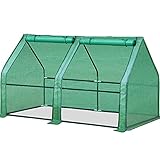 | Quictent Portable Greenhouse Large Size (71" WX 36" D X 36" H ) | Prime | Check Price on Amazon |
Raised Bed Border
If you have a yard with a steep slope, then raised garden bed borders are the thing for you. You can create the illusion of a level garden if you build the garden beds at their lowest section and gradually go up. Make the garden bed wide, so that you can have layers of flowers lining the border and there will be plenty of room for annuals and perennials to provide an attractive look.
Trough Gardens
This is a unique idea for a raised garden bed. Using animal feeding troughs to grow your plants will give it an unusual look. The troughs are deep enough for any plant to be grown; they also retain heat, which warms the plant. Just remember to drill some holes for drainage and you are set. You will also have to water your plants more often during the summer. It will give off a very chic look to your garden.
Recommended Trough Raised Beds
| Image | Title | Prime | Buy |
|---|---|---|---|
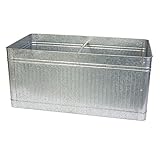 | Panacea 83475 Vintage Rectangle Raised Garden Bed Planter | Prime | Check Price on Amazon |
Top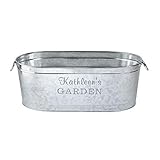 | Let's Make Memories Personalized Galvanized Planter Tub – Decorative Metal Flower Pot – Gardening Made Easy – Customize with Any 2-Line Message | Prime | Check Price on Amazon |
 | Nice Planter Corten Steel Trough | Prime | Check Price on Amazon |
 | Behrens 000-OV Hot Dipped Galvanized Steel Oval PlanterTub, 2 Gallon | Prime | Check Price on Amazon |
 | Achla Designs C-52 Embossed Oval Galvanized Steel Tub | PrimeEligible | Check Price on Amazon |
Custom-Designed Raised Beds
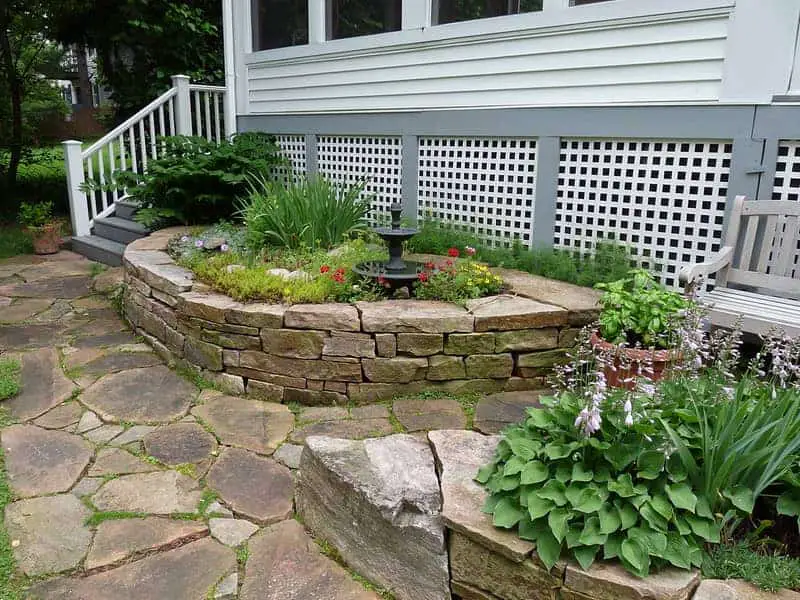
If you do not want to build your raised garden beds from scratch, you can also hire a landscaper to design a custom one. They will incorporate your ideas and make it according to your vision and taste. For a rustic appearance, you can add in a bench and lamppost near it as well.
Raised Bed with Trellis
If you want your vegetable garden to be neat and tidy, you can try using a trellis or arbor to give them the space to climb up rather than them sprawling on the ground. They are also easier to harvest in this way, allowing you to grow more plants without taking up much space. This design gives the plants access to sunshine too. Just create a simple frame by leaning the structure, tethering two bamboo poles together, and stretching a netting across them.
Recommended Raised Garden Bed with Trellis
| Image | Title | Prime | Buy |
|---|---|---|---|
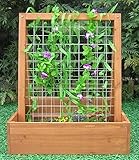 | Seny Garden Planter Raised Beds with Double Trellis, Height Standing Planters for Garden Yard | Prime | Check Price on Amazon |
 | Greenes Fence Premium Cedar Raised Garden Bed with Trellis | Prime | Check Price on Amazon |
Top | Best Choice Products Set of 2 48in Wood Planter Box & Diamond Lattice Trellis, Mobile Outdoor Raised Garden Bed for Climbing Plants w/Drainage Holes, Optional Wheels - Walnut | Prime | Check Price on Amazon |
 | Planter Box with Trellis Raised Garden Bed Outdoor for Flower Standing Vertical Lattice Panels for Vine 31" L x 12" W x 47" H | Prime | Check Price on Amazon |
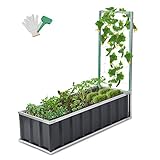 | CEED4U 4 L x 1.5 W Feet Metal Raised Garden Bed with Trellis, Planter Box Steel Kit with 15 Packs Plant Labels and 1 Pair of Gloves for Vegetables, Flower, Herbs, Fruits (Dark Grey) | PrimeEligible | Check Price on Amazon |
 | kinbor Planter Box with Trellis Set of 2, Raised Garden Bed Outdoor for Plants Hanging Flower Baskets Patio Garden Yard | Prime | Check Price on Amazon |
 | Giantex Set of 2 Plant Raised Bed with Trellis, Wood Planter Box for Flower Climbing, Standing Vertical Indoor Outdoor Plant Container for Garden Balcony Patio Yard Porch, 31.5"x16"x68" | Prime | Check Price on Amazon |
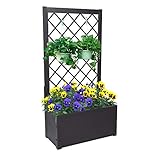 | Free Standing Plant Raised Bed with Trellis Elevated Flower Bed for Hanging Flower Baskets Patio Garden Yard | Prime | Check Price on Amazon |
Raised Beds Lining Walkway
When you have a small yard, even a well-maintained in-ground pathway garden looks cluttered and requires a lot of effort to maintain it properly. To overcome this, building a raised garden bed lining this pathway is a great idea, which makes pathway gardens look beautiful. Moreover, you can plan an all-season look by choosing different plants and planting in such a way that your small garden blooms in every season. You can build garden beds of different shapes using bricks and other materials. With pre-planning, these types of raised beds can make your small space look bigger and provide an awesome view.
Colorful Cinder Block Raised Bed
You can also build your raised garden bed using recycled material and give it a colorful designer look with paints. There are so many options, however concrete blocks are one of the most widely used and popular. Some gardeners use older cinder blocks, however some oppose the use of cinder blocks as they may contain fly ash, which may be harmful to use around edible plants.
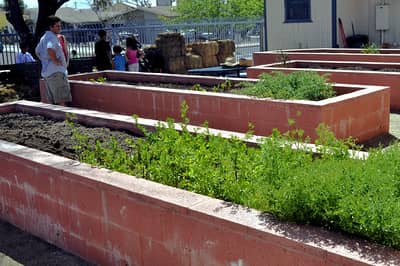
To avoid this ash issue, you can use new blocks of concrete to build your raised garden bed. Then, paint it in your favorite colors. While building such garden beds for planting vegetables, you should be aware of the fact that concrete blocks leech lime, which increases the pH of the soil. Increased pH makes the soil alkaline, so you should select the plants that preferably grow in alkaline conditions.
Tiered Raised Bed
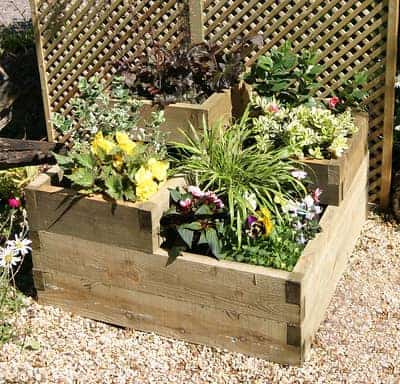
The tiered raised bed is a unique and great style of building raised garden beds. These raised garden beds have a stair-like structure. Its unique design and structure gives you flexibility to grow more plants in the same space. This style is more suitable for ornamental plants. You can use different tiers of these garden beds to plant different types of plants. For example, you can grow flowering plants on the top tier, while small herbs or shrubs can be planted in the lower tiers. These raised beds look very beautiful all year long and you can even decorate them during the holidays. You can also plant some trailing vines on the sides to increase its aesthetic look.
Recommended Tiered Raised Garden Bed Kits
| Image | Title | Prime | Buy |
|---|---|---|---|
 | Giantex 3 Tier Raised Garden Bed, 49’’x49’’x22 (LxWxH) | Prime | Check Price on Amazon |
 | Cyanhope 3 Tiered Cedar Raised Garden Bed Kit | Prime | Check Price on Amazon |
Top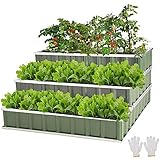 | FORTUNO 3 Tier Raised Garden Bed Metal 46.5x46.5x23.6 Inch | PrimeEligible | Check Price on Amazon |
 | ECOgardener Raised Bed Planter, 4’x4’. Outdoor Wooden Raised Garden Bed Kit Tiered Design. | PrimeEligible | Check Price on Amazon |
 | GROWNEER 3 Tier 4 x 4 x 2 Feet Dark Gray Metal Raised Garden Bed with 1 Pair of Gloves and 15 Pcs Plant Labels | PrimeEligible | Check Price on Amazon |
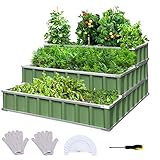 | KING BIRD 3 Tiers Raised Garden Bed 46’’x46’’x23.6’’ | Prime | Check Price on Amazon |
Door Panel Raised Beds
This is an idea to make a raised garden bed using spare or discarded doors. They look attractive and most do not require any painting or waterproofing. As doors are made to be strong and last long, a garden bed made from them will last longer too and discarded products will be put to good use.
Basic Square Garden Bed
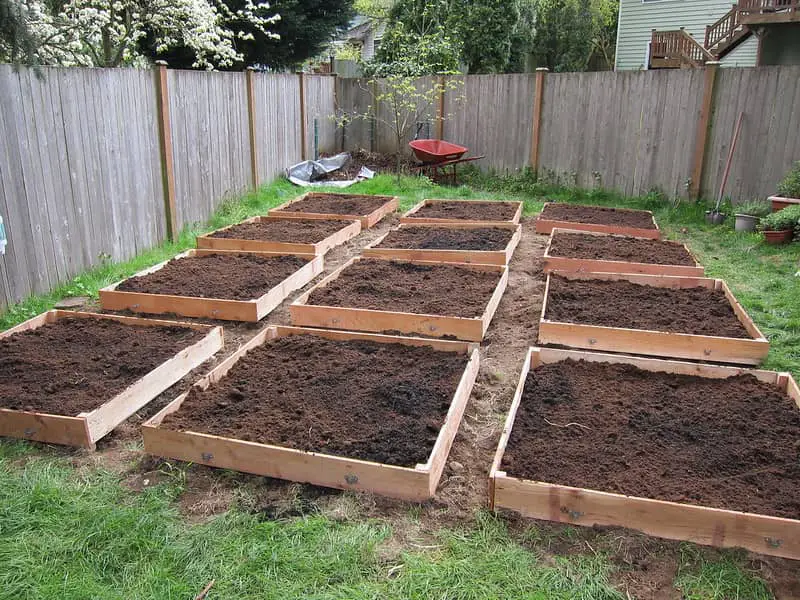
This is the perfect raised garden bed for you if you are a beginner. It is very simple and easy to make, and the square shape makes it easy to reach all areas of the planter. It is basically a no-frills garden bed, but is a great introduction into the intricacies of raised bed gardening and will make gardening easier for you.
Recommended Square Raised Garden Beds
| Image | Title | Prime | Buy |
|---|---|---|---|
 | Cedar Raised Garden Bed Kit - Fast Assembly, No Tools Needed - 1.5" Thick Boards - (48" x 48" x 12") - Naturally Rot-Resistant Wood – by Boldly Growing | PrimeEligible | Check Price on Amazon |
Top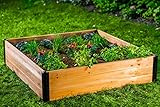 | Vita Mezza 4'x4'x11 Modular Garden Aluminum Posts, Cedar | Prime | Check Price on Amazon |
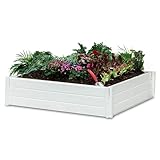 | Clean Earth Works - 48" x 48" Square White Vinyl Planter Box | PrimeEligible | Check Price on Amazon |
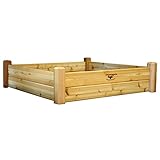 | Gronomics RGB 48-48 48-Inch by 48-Inch by 13-Inch Raised Garden Bed, Unfinished | Prime | Check Price on Amazon |
 | Quictent 48"x48"x11" Raised Garden Bed Kit with 8 Corner Brackets 4x4 Gloves Included | Prime | Check Price on Amazon |
Milk Crate Raised Garden Bed
You can use old milk crates and turn them into raised garden beds. It is very easy to set up and portable too. If you want to plant your herbs and vegetables near your kitchen, you can just plant your milk crate raised garden bed there. If you want to change their place, just pick it up and do it. It is as easy as it sounds. The great thing about them is that these crates come with drainage holes so there is no need to drill.
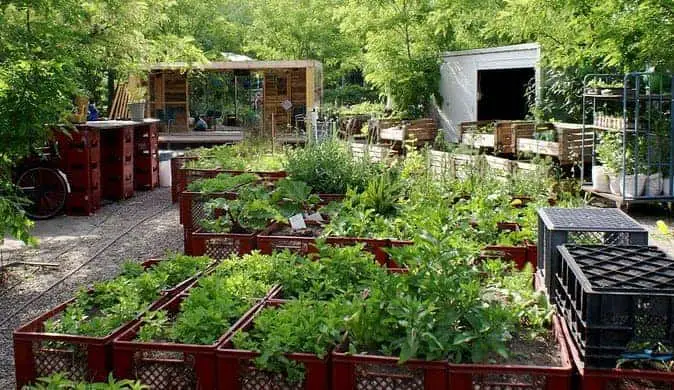
Raised garden beds have many advantages. They are a great way to get into gardening and are one of the easiest ways to do so. They let you grow various plants without worrying about space and lend an aesthetic appeal. So, go ahead and plant your own raised garden bed!

Darrell has a passion for gardening that he inherited from his father. Go here to read more about the influence his father played in his love for gardening. If you want to send Darrell a quick message, then visit his contact page here.



![10 Common Container Garden Mistakes to Avoid [Beginner’s Guide]](https://wraxly.com/wp-content/uploads/2021/02/10-Common-Container-Garden-Mistakes-to-Avoid-Beginners-Guide-1200-1024x576.webp)